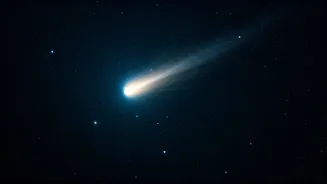Comet 3I/ATLAS Arrival
The interstellar comet 3I/ATLAS is set to make its closest approach to Earth on October 29, 2025, a date scientists and astronomy enthusiasts have marked
on their calendars. This comet is not just another space rock; it is a visitor from outside our solar system, making its journey even more intriguing. This unique origin allows researchers to study its composition and origin, potentially revealing valuable details about the formation of other planetary systems. The event offers a rare chance for both professional astronomers and amateur skywatchers to witness a comet with interstellar origins, providing an extraordinary educational experience and an opportunity to marvel at the wonders of the cosmos.
Why This Matters
The arrival of 3I/ATLAS is significant for several reasons. Firstly, it offers a chance to study an object that has traveled through interstellar space, providing insights into the conditions and materials found beyond our solar system. The comet's composition could offer clues about the origins of our solar system and the processes that shaped it. Secondly, the event provides a learning opportunity for people around the world. Observing this comet allows a deeper understanding of celestial mechanics and the vastness of space. The rare nature of interstellar comets makes each sighting an educational experience, enriching our understanding of the universe and its origins. The event also fosters a sense of wonder and curiosity about the cosmos.
Observing the Comet
To observe 3I/ATLAS, a few essential steps must be followed. The best viewing prospects often involve moving away from city lights, as light pollution can significantly reduce visibility. Dark, clear skies are crucial, and using binoculars or a telescope can enhance the viewing experience. The exact path of the comet across the sky will be predictable, with information available from astronomical societies and online resources. It is advisable to consult these sources closer to the date of the event for updated charts and viewing times. Keeping an eye on weather forecasts is equally essential, as clear skies are necessary to enjoy the celestial spectacle. Regular checking of astronomy websites and social media updates can also provide real-time information and insights into the best viewing strategies.
FAQs: Key Questions
Several frequently asked questions arise regarding the observation of 3I/ATLAS. Many wonder how bright the comet will appear. The brightness depends on several factors, including its size and distance from the sun and Earth. However, comets are notorious for their unpredictable nature, and the comet's brightness can vary. Secondly, people often ask if the comet poses any threat to Earth. Rest assured, 3I/ATLAS is not expected to collide with Earth. Its trajectory is well-charted, ensuring it will safely pass by. Another common question is, what can one expect to see? Viewers may observe a fuzzy object, perhaps with a tail, depending on its brightness and the viewing equipment. Finally, people often seek information about the best time and location to view the comet. This data is available from astronomical resources as the event approaches.
Scientific Importance
Scientifically, the study of 3I/ATLAS presents incredible opportunities. Scientists can study the comet's composition to learn more about the interstellar medium and the materials that exist between stars. The comet is expected to provide data on the formation of comets and planetary systems. By analyzing the light reflected from the comet, scientists can determine the types of molecules it contains and thus infer the conditions under which it formed. This, in turn, can help us understand the process of star formation and planet formation in general. The close approach of the comet will offer an unparalleled opportunity to study interstellar space samples without having to send a spacecraft to another star system.
Preparing for 2025
To prepare for the comet's arrival on October 29, 2025, it is advantageous to start early. Familiarize yourself with basic astronomy concepts, such as identifying constellations and understanding how to read star charts. Locate local astronomy clubs and societies that can offer workshops, observing sessions, and updates on the comet's location. Consider investing in binoculars or a small telescope, which will greatly improve the viewing experience. Moreover, keep updated with the latest astronomical news. Staying informed helps maximize the chances of successfully observing 3I/ATLAS. Finally, share this upcoming astronomical event with friends and family to help create a shared sense of excitement and wonder as the date draws closer.












